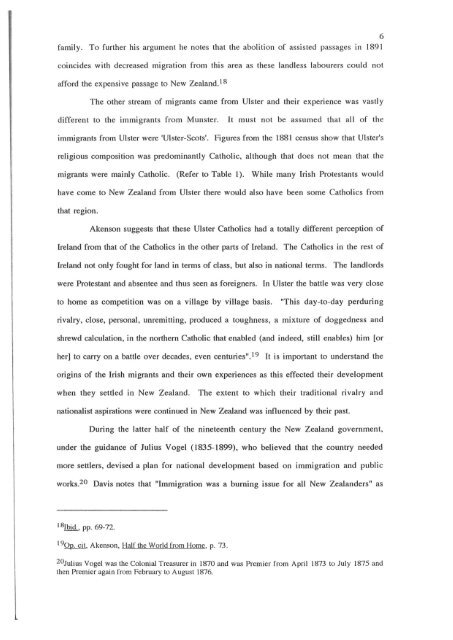TRANSPLANTED IRISH INSTITUTIONS - University of Canterbury
TRANSPLANTED IRISH INSTITUTIONS - University of Canterbury
TRANSPLANTED IRISH INSTITUTIONS - University of Canterbury
Create successful ePaper yourself
Turn your PDF publications into a flip-book with our unique Google optimized e-Paper software.
6<br />
family. To further his argument he notes that the abolition <strong>of</strong> assisted passages in 1891<br />
coincides with decreased migration from this area as these landless labourers could not<br />
afford the expensive passage to New Zealand. I 8<br />
The other stream <strong>of</strong> migrants came from Ulster and their experience was vastly<br />
different to the immigrants from Munster.<br />
It must not be assumed that all <strong>of</strong> the<br />
immigrants from Ulster were 'Ulster-Scots'. Figures from the 1881 census show that Ulster's<br />
religious composition was predominantly Catholic, although that does not mean that the<br />
migrants were mainly Catholic. (Refer to Table 1). While many Irish Protestants would<br />
have come to New Zealand from Ulster there would also have been some Catholics from<br />
that region.<br />
Akenson suggests that these Ulster Catholics had a totally different perception <strong>of</strong><br />
Ireland from that <strong>of</strong> the Catholics in the other parts <strong>of</strong> Ireland. The Catholics in the rest <strong>of</strong><br />
Ireland not only fought for land in terms <strong>of</strong> class, but also in national terms. The landlords<br />
were Protestant and absentee and thus seen as foreigners. In Ulster the battle was very close<br />
to home as competition was on a village by village basis.<br />
"This day-to-day perduring<br />
rivalry, close, personal, unremitting, produced a toughness, a mixture <strong>of</strong> doggedness and<br />
shrewd calculation, in the northern Catholic that enabled (and indeed, still enables) him [or<br />
her] to carry on a battle over decades, even centuries". 19 It is important to understand the<br />
origins <strong>of</strong> the Irish migrants and their own experiences as this effected their development<br />
when they settled in New Zealand.<br />
The extent to which their traditional rivalry and<br />
nationalist aspirations were continued in New Zealand was influenced by their past.<br />
During the latter half <strong>of</strong> the nineteenth century the New Zealand government,<br />
under the guidance <strong>of</strong> Julius Vogel (1835-1899), who believed that the country needed<br />
more settlers, devised a plan for national development based on immigration and public<br />
works. 20 Davis notes that "Immigration was a burning issue for all New Zealanders" as<br />
18Ibid .. pp. 69-72.<br />
190p. cit, Akenson, Half the World from Home, p. 73.<br />
20Julius Vogel was the Colonial Treasurer in 1870 and was Premier from April 1873 to July 1875 and<br />
then Premier again from February to August 1876.
















